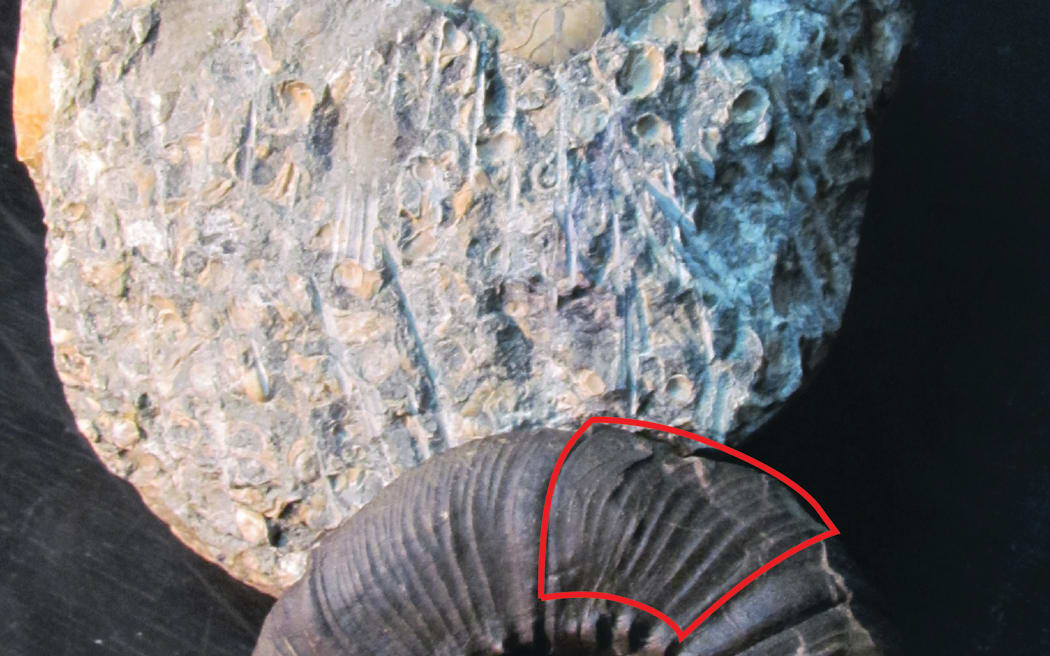
The giant Maungataniwha fossilised ammonite (rear), compared against a smaller, complete ammonite fossil which is 165mm in diameter. The area outlined in red on the smaller specimen indicates the section discovered at Maungataniwha. Photo: SUPPLIED
Dinosaur fossil hunter and conservationist Peter Shaw says the heavy rain brought by Cyclone Gabrielle has reset the landscape making it easier to unearth treasures in some places but more difficult in others.
Until palaeontologist Joan Wiffen discovered dinosaur bones there in the 1970s we thought Aotearoa was dinosaur free.
By the early 2020s it was thought all the significant fossils had been uncovered.
Then a year ago today Cyclone Gabrielle hit. The heavy rains reset the landscape, potentially making new treasures visible.
In breaks from his main job, restoring the native bush Pete Shaw - manager of the Forest Lifeforce Restoration has been keeping Joan's legacy alive and working there since 2002.
To get to the southern Maungataniwha ranges you can drive about an hour north of Napier and then go inland on the Willow Flat Road for another hour.
The region does not just have fossils, he said.
"It's remote and it's the biggest patch of forest in the North Island, so it's pretty special in that regard, it's got some pretty special species in there, still got kiwi in the Maungataniwha, quite good numbers and other rare species whio, kākā, kakabeak which are just about gone from the wild, so it's a pretty special neck of the woods."
The initial fossils were found by oil geologist Don Haw back in the 1950s, he made a map which was picked up by Joan Wiffen - they did not know where the site was but managed to find it, he said.
"The rest is history really because they found the first land dinosaur fossils for the country and changed all of our thinking around Aotearoa's geological history."
The dinosaur fossils were preserved in a marine environment but the dinosaurs were terrestrial so it was only possible to find bits and pieces such as a rib that had ended up in the harbour, he said.
Shaw said conservation was his core business but fossil hunting was a side hobby and if he had some spare time he might take a look in a creek for fossils.
"You don't actually hunt for fossils oddly enough, you hunt for the compressions that they're found in. So you really get your eye into the particular type of rock that the fossils are preserved in cause it's quite different from the surrounding bedrock."
The rocks that fossils are preserved in are usually much harder than the surrounding rocks, he said.
"So normally I give them a hammer and say tap the rocks until you find the ones that ring like steel and they're the good ones and they're the ones you need to search for."
If you do find a compression rock then you need to examine it closely in the hope of finding something special, he said.
"Earlier this year we found a compression in a valley, we actually call it the Wiffen Valley after Joan and Mont Wiffen of course, and walking up the creek spotted a bit of compression rock and fully exposed were six vertebrae in a line and what looked like finger bones and it was part of the back bone and the paddle of an elasmosaurus, so one of those great big green reptiles that scooted around in the ocean at the same time as the dinosaurs were on the land."
Up until Cyclone Gabrielle, which was the first big rain event since Cyclone Bola, the creeks in the region had been surprisingly stable and so it was the first time everything had got jumbled around and turned over, he said.
"So really it's a blank canvas again."
In some places the slips, washed out creeks and land changes caused by the cyclone have made fossil hunting more difficult because parts of the stream bed have been smothered in other materials that are not fossil bearing, he said.
"But other places it's been rubbed raw again if you like and it's pretty cool to go into those sites."
Shaw said if they find something they photograph it and send the images to GNS which has experts on hand who are usually able to identify what has been found - but not always.
"It's that idea that you might find something that's completely new to science that sort of keeps you going."
It was unusual to be able to carry the suspected fossil out of the area because generally they were in large hunks of rock, he said.
"There's quite an act to get them flown out if we have to fly them out, we only fly out the extra special ones obviously."

